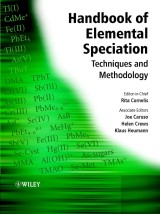Details

Handbook of Elemental Speciation
Techniques and Methodology1. Aufl.
|
414,99 € |
|
| Verlag: | Wiley |
| Format: | |
| Veröffentl.: | 09.01.2004 |
| ISBN/EAN: | 9780470868379 |
| Sprache: | englisch |
| Anzahl Seiten: | 670 |
DRM-geschütztes eBook, Sie benötigen z.B. Adobe Digital Editions und eine Adobe ID zum Lesen.
Beschreibungen
This international collection of chapters comprehensively covers different aspects of procedures for speciation analysis at all levels starting from sample collection and storage, through sample preparation approaches to render the species chromatographable, principles of separation techniques used in speciation analysis, to the element specific detection. <ul> <li>International renowned editors and contributors</li> <li>Includes coverage of electrochemical methods, biosensors for metal ions, radioisotope techniques and direct solid speciation techniques</li> <li>Provides information on quality assurance and risk assessment, and speciation-relevant legislation</li> </ul> <p>Each chapter is a stand-alone reference covering a given facet of elemental speciation analysis written by an expert in a given field with the volume as a whole providing an excellent introductory text and reference handbook.</p>
<b>List of Contributors.</b> <p><b>Preface.</b></p> <p><b>Technical Abbreviations and Acronyms.</b></p> <p>1 Introduction.</p> <p>2 Sampling: Collection, Storage.</p> <p>2.1 Sampling: Collection, Processing and Storage of Environmental Samples.</p> <p>2.2 Sampling of Clinical Samples: Collection and Storage.</p> <p>2.3 Food: Sampling with Special Reference to Legislation, Uncertainty and Fitness for Purpose.</p> <p>2.4 Sampling: Collection, Storage – Occupational Health.</p> <p>3 Sample Preparation.</p> <p>3.1 Sample Treatment for Speciation Analysis in Biological Samples.</p> <p>3.2 Sample Preparation Techniques for Elemental Speciation Studies.</p> <p>3.3 Sample Preparation – Fractionation (Sediments, Soils, Aerosols and Fly Ashes).</p> <p>4 Separation Techniques.</p> <p>4.1 Liquid Chromatography.</p> <p>4.2 Gas Chromatography and Other Gas Based Methods.</p> <p>4.3 Capillary Electrophoresis in Speciation Analysis.</p> <p>4.4 Gel Electrophoresis for Speciation Purposes.</p> <p>5 Detection.</p> <p>5.1 Atomic Absorption and Atomic Emission Spectrometry.</p> <p>5.2 Flow Injection Atomic Spectrometry for Speciation.</p> <p>5.3 Detection by ICP-Mass Spectrometry.</p> <p>5.4 Plasma Source Time-of-flight Mass Spectrometry: a Powerful Tool for Elemental Speciation.</p> <p>5.5 Glow Discharge Plasmas as Tunable Sources for Elemental Speciation.</p> <p>5.6 Electrospray Methods for Elemental Speciation.</p> <p>5.7 Elemental Speciation by Inductively Coupled Plasma-Mass Spectrometry with High Resolution Instruments.</p> <p>5.8 On-line Elemental Speciation with Functionalised Fused Silica Capillaries in Combination with DIN-ICP-MS.</p> <p>5.9 Speciation Analysis by Electrochemical Methods.</p> <p>5.10 Future Instrumental Development for Speciation.</p> <p>5.11 Biosensors for Monitoring of Metal Ions.</p> <p>5.12 Possibilities Offered by Radiotracers for Method Development in Elemental Speciation Analysis and for Metabolic and Environmentally Related Speciation Studies.</p> <p>6 Direct Speciation of Solids.</p> <p>6.1 Characterization of Individual Aerosol Particles with Special Reference to Speciation Techniques.</p> <p>6.2 Direct Speciation of Solids: X-ray Absorption Fine Structure Spectroscopy for Species Analysis in Solid Samples.</p> <p>7 Calibration.</p> <p>7.1 Calibration in Elemental Speciation Analysis.</p> <p>7.2 Reference Materials.</p> <p>8 Screening Methods for Semiquantitative Speciation Analysis.</p> <p>9 Risk Assessments/Regulations.</p> <p>9.1 Environmental Risk Assessment and the Bioavailability of Elemental Species.</p> <p>9.2 Speciation and Legislation.</p> <p><b>Index.</b></p>
"This book provides broad coverage of the different aspects of the analysis of elemental species..." (<i>Journal of the American Chemistry Society</i>, 2004 Vol. 126) <p>"...a welcome contribution to the literature...will provide a useful insight..." (Trends in Analytical Chemistry, Vol 23(4), April 2004)</p> <p>"...the reader can use this book as a reference book for the next 5 to 10 years.." (Applied Organmettallic Chemistry, Jan 2004)</p> <p>"...a long-awaited high-quality handbook...will be of great value in both academia and industry." (Angewandte Chemie, Vol.43, No.42, 25<sup>th</sup> October 2004)</p> <p>"Each chapter, written by an expert on the field, is a stand alone reference...an excellent introductory text" (International Journal of Environmental Analytical Chemistry 2004)</p> <p>"...provides an excellent compendium of information on all the important methods of speciation analysis..." (Analytical & Bioanalytical Chemistry, No.380, 2004)</p> <p>"...this is a long-awaited high-quality handbook for speciation analysis ...(and) has the potential to become one of the most frequently used books in the personal shelves of specialists in the field and teachers of analytical chemistry!" (also in German, Angewandte Chemie, 2004; Vol 43; No. 42)</p>
<p><b>Rita Cornelis</b>, Department of Analytical Chemistry, Ghent University, The Netherlands.</p>
The areas of speciation analysis have being undergoing a continual evolution and development for the last 20 years. A fundamental tool for speciation analysis has been the combination of a chromatographic separation technique with atomic spectrometry, permitting a sensitive and specific detection of the target element. Recent impressive progress toward lower detection limits in ICP-MS, toward higher resolution in separation techniques, especially capillary electrophoresis and electro-chromatography, and toward higher sensitivity in electrospray mass spectrometry for molecule-specific detection at trace levels in complex matrices has allowed new frontiers to be crossed. <p>This first volume of <i>The Handbook of Elemental Speciation</i>, brings together a collection of chapters covering comprehensively different aspects of procedures for speciation analysis at the different levels starting from sample collection and storage, through sample preparation approaches to render the species chromatographable, principles of separation techniques used in speciation analysis, to the element specific detection. This already very broad coverage of analytical techniques is completed by electrochemical methods, biosensors for metal ions, radioisotope techniques and direct solid speciation techniques. Special concern is given to quality assurance and risk assessment, and speciation-relevant legislation.</p> <p>Each chapter is a stand-alone reference covering a given facet of elemental speciation analysis written by an expert in a given field with the volume as a whole providing an excellent introductory text and reference handbook for analytical chemists in academia, government laboratories and industry, regulatory managers, biochemists, toxicologists, clinicians, environmental scientists, and students of these disciplines.</p> <p>The second volume will present in detail a summary of each key element determined by speciation methods, and its detection and measurement within the four key areas of the environment, food, occupation and clinical health. .</p>


















